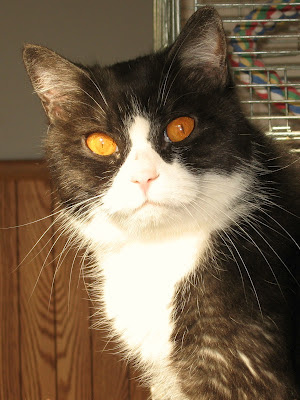This is called "burn out."
2012 will be my thirteenth year in animal rescue and my seventh year in medicine. I’ve figured out how to protect myself: I know my limits, and I’ve learned how to say no. But no matter how many walls there are between me and all the heartache, it still creeps in. For example, in 2009 I had two of my foster puppies euthanized for severe behavioral issues. Two of them. I had ten years of experience in rescue under my belt, and I almost cashed in my chips and walked away.
Instead, I went home and dug out my You-Don't-Suck box. In this box are little notes with all the good things I've done. There’s a picture of Mikey in this box. There’s a note from a manager in an entirely different department of the hospital than the one I work in saying that she noticed how helpful I was to both my patients and her staff.
Some of the notes are just single words, reminders to me of the lives I’ve changed for the better. There’s a scrap of paper with the word “Lindberg” on it. Lindberg was a black retriever mix that came to my shelter on a sweltering June day. He cowered in the back of his kennel, growling and muzzled and oh yeah - covered in ticks. I went slow, and I spent four hours pulling ticks off this dog - two hundred sixty-four of them, to be exact. I still remember the number eleven years later. But Lindberg seemed to shed his misery with each tick. At the end of the four hours, the muzzle was gone and Lindberg was curled in my lap. Sleeping. He went on to be adopted by a family with two little kids, the whole bunch of them thrilled with their new lives.
My You-Don't-Suck box is what keeps me going when I can't remember why I do this to myself.
I think every reactive dog owner should have a You-Don't-Suck box. Because there will be days when you go home feeling like the worst dog owner in the universe. Days when there is no silver lining. When you question not only your ability to train, but whether you have any right to own a dog like this to begin with. And no amount of empathetic consolation, motivational quotes, or puppy kisses will help at all, not when you suck that bad.
Rubi's You-Don't-Suck box is jam-packed. First, there's the day I decided that I would not be just another person in Rubi's life who let her down. And the first time she chose me over a strange dog. Our first Dog Safety Program. The utterly uneventful trip to the vet. Rubi and I have done a lot, and most of it has been wonderful. We're great together, and the occasional bad day - well, that's normal. Sometimes, I screw up. Sometimes, Rubi has PMS. Sometimes, this is the same day. Every time I feel like giving up, I dig out my You-Don't-Suck box and remember that I love her, I love what we do, and we need to keep going. Because she's worth it.
Reminding myself that I don't suck gives me more hope for the future than any plans for change or forced optimism possibly could. And hope is what carries you when walking the walk gets harder than walking away.
Some of the notes are just single words, reminders to me of the lives I’ve changed for the better. There’s a scrap of paper with the word “Lindberg” on it. Lindberg was a black retriever mix that came to my shelter on a sweltering June day. He cowered in the back of his kennel, growling and muzzled and oh yeah - covered in ticks. I went slow, and I spent four hours pulling ticks off this dog - two hundred sixty-four of them, to be exact. I still remember the number eleven years later. But Lindberg seemed to shed his misery with each tick. At the end of the four hours, the muzzle was gone and Lindberg was curled in my lap. Sleeping. He went on to be adopted by a family with two little kids, the whole bunch of them thrilled with their new lives.
My You-Don't-Suck box is what keeps me going when I can't remember why I do this to myself.
I think every reactive dog owner should have a You-Don't-Suck box. Because there will be days when you go home feeling like the worst dog owner in the universe. Days when there is no silver lining. When you question not only your ability to train, but whether you have any right to own a dog like this to begin with. And no amount of empathetic consolation, motivational quotes, or puppy kisses will help at all, not when you suck that bad.
Rubi's You-Don't-Suck box is jam-packed. First, there's the day I decided that I would not be just another person in Rubi's life who let her down. And the first time she chose me over a strange dog. Our first Dog Safety Program. The utterly uneventful trip to the vet. Rubi and I have done a lot, and most of it has been wonderful. We're great together, and the occasional bad day - well, that's normal. Sometimes, I screw up. Sometimes, Rubi has PMS. Sometimes, this is the same day. Every time I feel like giving up, I dig out my You-Don't-Suck box and remember that I love her, I love what we do, and we need to keep going. Because she's worth it.
Reminding myself that I don't suck gives me more hope for the future than any plans for change or forced optimism possibly could. And hope is what carries you when walking the walk gets harder than walking away.



.JPG)


